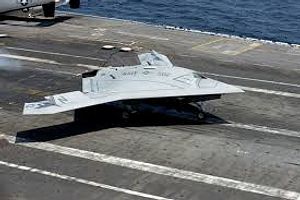What role will drones play in planning for high intensity war in the Pacific? A recent report from the USNI indicates that the Navy is planning to use the UCLASS UAV, an F-14-sized piece of equipment with some stealth characteristics, as a potential missile truck. Although knowledge that drones had a role to play in air superiority had become more or less widespread within the national security community, this is one of the best descriptions of how, specifically, the Navy envisions integrating its drones into its air defense system.
The question of how UAVs will contribute to air superiority goes to the core of the utility not just of the UCLASS, but also of the F-35C. If we envision the JSF as the centerpiece of a networked system-of-systems that includes subsurface, surface, and unmanned aerial assets, part of a chain of capabilities between see-er and shooter, it begins to look like a much more formidable weapon, its drawbacks as a fighter notwithstanding.
The practical objections to the use of UAVs for air superiority are well known. UAVs lack the situational awareness of piloted aircraft, and are extremely vulnerable to electronic counter-measures that can disrupt communications with their operators. Even a few seconds delay in relaying commands can prove fatal for a UAV. At the same time, developing drones sufficiently autonomous to manage themselves in air-to-air combat is genuinely scary; no one wants a drone that can kill on its own.
But if we evaluate the contribution of the drone not in isolation, but rather as part of a system-of-systems for air dominance, its utility becomes clearer. Stealthy F-35s operate in contested environments, identifying and tracking targets, with the UAVs supplying the missiles that the JSFs can’t carry on their own. Even the payload challenged F-35B can contribute in this context; having as many F-35s in the air as possible increases the clarity of the picture offered to pilots and commanders.
Indeed, this is precisely the type of aerial warfare that the developers of the F-35 envisioned. Although this vision has been part of the Joint Strike Fighter program for some time, it has not, for whatever reason, been articulated clearly to the public. Our public conversation still struggles to conceptualize specific weapons as part of a larger system, rather than with respect to their individual characteristics. This hardly means that programs such as the F-35 or the UCLASS should be above criticism, but it does suggest ways to add nuance to the critique.
It’s not a stretch to argue that the F-35C and the UCLASS UAV will structure American naval aviation for the foreseeable future. These reports give us a better indication of how the capabilities can be expected to work together, and help illuminate the utility of both programs.

































